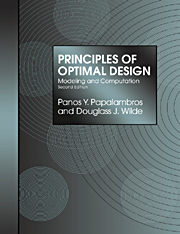8 - Principles and Practice
Summary
Im Anfang war die Tat. (In the beginning was the Act.)
J. W. von Goethe (1749–1832)In designing, as in other endeavors, one learns by doing. In this sense the present chapter, although at the end of the book, is the beginning of the action. The principles and techniques of the previous chapters will be summarized and organized into a problem-solving strategy that can provide guidance in practical design applications. Students in a design optimization course should fix these ideas by applying them to a term project. For the practicing designer, actual problems at the workplace can serve as first trials for this new knowledge, particularly if sufficient experience exists for verifying the first results.
The chapter begins with a review of some modeling implications derived from the discussion in previous chapters about how numerical algorithms work. Although the subject is quite extensive, our goal here is to highlight again the intimacy between modeling and computation that was explored first in Chapters 1 and 2. The reader should be convinced by now of the validity of this approach and experience a sense of closure on the subject.
The next two sections deal with two extremely important practical issues: the computation of derivatives and model scaling. Local computation requires knowledge of derivatives. The accuracy by which derivatives are computed can have a profound influence on the performance of the algorithm. A closed-form computation would be best, and this has become dramatically easier with the advent of symbolic computation programs.
- Type
- Chapter
- Information
- Principles of Optimal DesignModeling and Computation, pp. 337 - 368Publisher: Cambridge University PressPrint publication year: 2000



